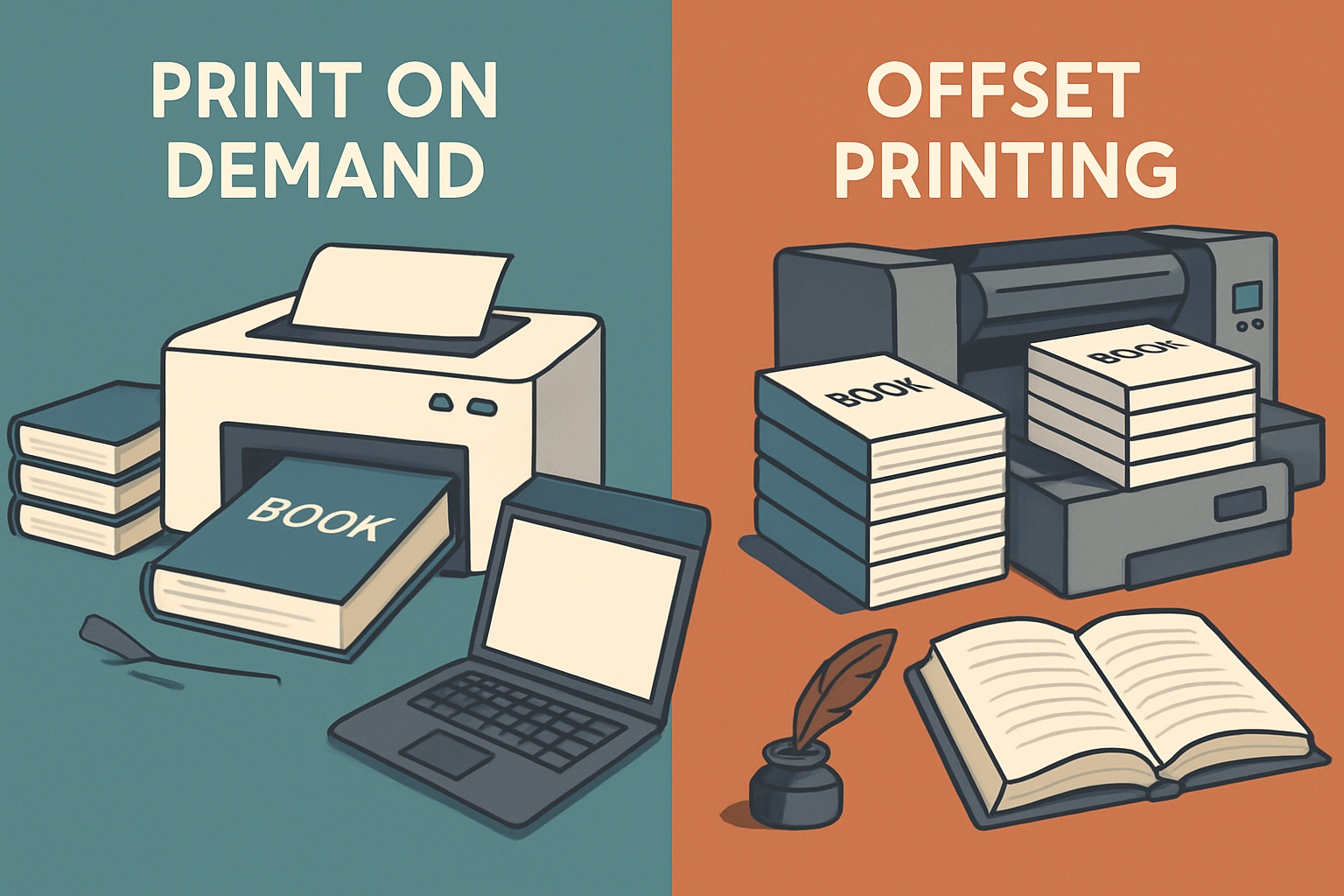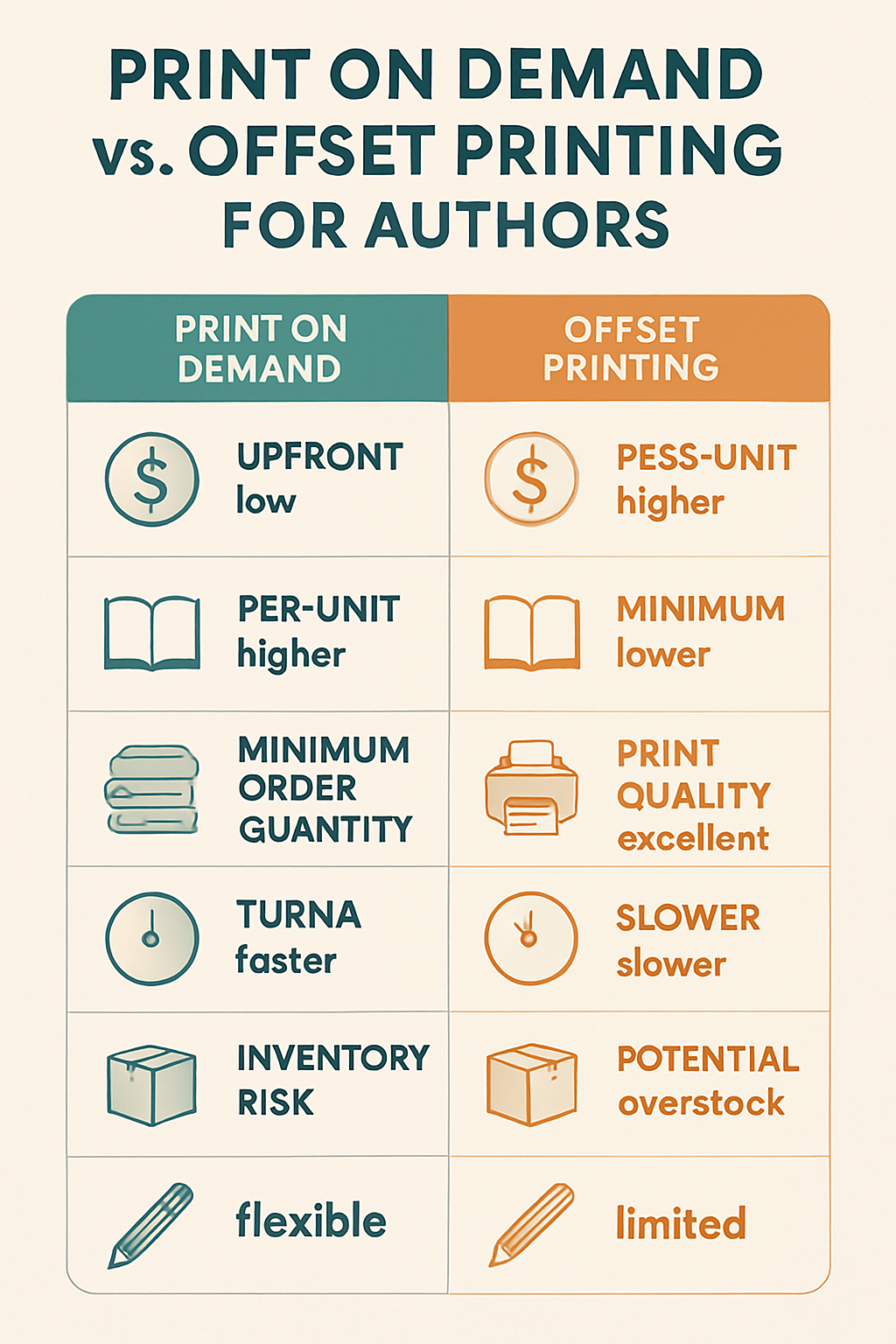
Hey fellow authors! Have you ever found yourself staring at your manuscript, dreaming of holding your published book in your hands,
but then getting completely overwhelmed by the printing options?
Trust me, you’re not alone. The world of book printing can feel like a maze, especially when you encounter terms like ‘Print on Demand’ (POD) and ‘Offset Printing.’
It’s a crucial decision that impacts everything from your budget and book quality to your distribution and profit margins.
As an author, I’ve been there, trying to figure out the best path for my own work.
So, let’s break it down together, making sense of these two primary printing methods so you can confidently choose the one that aligns perfectly with your publishing goals.

Videos are added as random thoughts 💭 💭 💭…
Understanding Print on Demand (POD)
Print on Demand, often simply called POD, has revolutionized the publishing industry, particularly for independent and self-published authors.
Imagine a world where your book isn’t printed until someone actually orders it. That’s the magic of POD!
There’s no need for massive upfront print runs or warehouses full of unsold copies.
When a customer buys your book from an online retailer, the order goes directly to the POD service, which then prints a single copy and ships it out.
It’s an incredibly efficient, just-in-time system.
The Upsides of POD for Authors
One of the biggest advantages of POD is the reduced financial risk [1].
As authors, we often pour our hearts and souls (and sometimes our life savings) into our books.
POD eliminates the need for large upfront investments in printing, which can be a huge relief.
This means you don’t have to worry about minimum order quantities (MOQs) or being stuck with hundreds of books you can’t sell.
It’s perfect for testing the waters with a new title or for niche markets where demand might be lower.
Accessibility and speed are also major benefits. Getting your book listed on major online retailers like Amazon, Barnes & Noble, and others becomes much simpler.
The technical setup is generally quicker and less involved compared to traditional printing methods [2].
Once your files are uploaded and approved, your book can be available for purchase almost immediately.
This rapid turnaround time is a game-changer for authors eager to get their stories into readers’ hands.
Furthermore, POD offers inventory management simplicity.
Since books are printed only when ordered, you don’t have to manage storage, shipping, or returns yourself.
The POD service handles all of that, freeing you up to focus on what you do best: writing and marketing your next masterpiece.
This also means no unsold inventory which can be a significant financial drain for authors who opt for larger print runs.
The Downsides of POD to Consider
While POD offers many advantages, it’s not without its drawbacks.
One common concern is lower profit margins per book [3].
Because each book is printed individually, the per-unit cost tends to be higher than with offset printing, especially for larger quantities.
This can eat into your royalties, making it harder to earn a substantial income from each sale.
Quality control challenges can also arise.
While POD technology has come a long way, the consistency of print quality can sometimes vary between different service providers or even between batches from the same provider.
You might find slight differences in color reproduction, paper stock, or binding quality.
It’s crucial to order physical proofs and thoroughly review them before making your book live.
Another limitation is the restricted customization and material options.
POD services typically offer a more limited range of paper types, cover finishes, and binding options compared to offset printing.
If you have a very specific vision for your book’s physical appearance, POD might not offer the flexibility you need to achieve it.
Also, product availability can be dependent on the POD service, meaning any issues on their end could impact your book’s availability [3].
Exploring Offset Printing
Offset printing is the traditional workhorse of the printing world, responsible for the vast majority of books you see in bookstores.
It’s a method that uses large plates or cylinders to transfer an inked image onto a rubber blanket, which then rolls the image onto paper [4].
This process is highly efficient and cost-effective when printing large volumes.
The Advantages of Offset Printing
The most significant advantage of offset printing is its cost efficiency at scale [5].
The more books you print, the lower the per-unit cost becomes.
For authors planning to sell thousands of copies, or those with guaranteed distribution through traditional publishers, offset printing offers a much better return on investment.
The initial setup costs are higher, but these are spread out over a large number of books, making each individual copy cheaper.
Superior print quality and consistency are hallmarks of offset printing.
It’s known for producing the highest quality prints with flawless detail, vibrant colors, and excellent color balance [6].
If you’re particular about the visual appeal of your book, especially if it’s a heavily illustrated children’s book, a photography book, or a graphic novel, offset printing often delivers a more professional and polished result.
The consistency across an entire print run is also exceptional, ensuring every copy looks identical.
Offset printing also provides greater flexibility in book design and materials [6].
You’ll have a much wider range of paper stocks, cover finishes (like embossing, foil stamping, or spot UV), and binding options to choose from.
This allows for more creative and visually appealing results, giving your book a unique and premium feel that can stand out on shelves.
You can truly bring your artistic vision to life with offset printing.
The Disadvantages of Offset Printing
Despite its benefits, offset printing comes with its own set of challenges.
The most notable is the high upfront cost [6].
Preparing the printing plates and setting up the presses requires a significant initial investment.
This can be a major barrier for independent authors or those with limited budgets, as you’ll need to pay for the entire print run before you see a single book.
Offset printing also typically involves medium to high minimum order quantities (MOQs) [6].
This means you’ll need to order a substantial number of books, often hundreds or even thousands, in a single run.
This commitment can lead to inventory management headaches if your books don’t sell as quickly as anticipated.
You’ll need space to store all those books, and you’ll be responsible for shipping and fulfillment, which adds to your workload and expenses.
Finally, the longer turnaround times are a consideration.
The entire process, from setting up the plates to printing and binding, takes much longer than POD.
This means you’ll need to plan well in advance and be prepared for a waiting period before your books are ready.
If you’re looking for a quick launch, offset printing might not be the best option.
Print on Demand vs. Offset Printing: A Side-by-Side Comparison
To help you visualize the differences, let’s look at a quick comparison:

Making Your Decision: Which is Right for You?
So, how do you choose? It really boils down to your specific needs, goals, and resources as an author.
There’s no single right answer, only the best answer for your situation.
Consider POD if:
You are a first-time author or self-publisher with a limited budget and want to minimize financial risk. The ability to publish without a large upfront investment is incredibly liberating.
You want to test the market for a new book idea or a niche genre without committing to a large print run. POD allows you to gauge reader interest before scaling up.
You prefer a hands-off approach to inventory and fulfillment.
Let the POD service handle the logistics so you can focus on writing and marketing.
Your book is primarily text-based and doesn’t require highly specialized printing techniques or premium finishes.
You need a fast turnaround to get your book to market quickly.
Consider Offset Printing if:
You have a guaranteed demand for a large number of books, perhaps through pre-orders, a successful crowdfunding campaign, or traditional publishing deal. This is where the cost savings really kick in.
You prioritize superior print quality and extensive customization for your book.
If your book features intricate illustrations, photographs, or requires specific paper stocks and finishes to achieve a particular aesthetic, offset is the way to go.
You have the budget for a significant upfront investment and the resources to manage inventory, storage, and distribution.
You are publishing a high-volume title where the per-unit cost reduction will significantly impact your profit margins.
You are looking for the highest possible quality and consistency across your entire print run.
Hybrid Approaches and Final Thoughts
It’s also worth noting that many authors use a hybrid approach.
You might start with POD to get your book out quickly, test the market, and gather initial reviews.
Once you have proven demand and a clearer understanding of your sales potential, you could then invest in a larger offset print run for higher quality, better profit margins, or special editions.
This strategy allows you to leverage the benefits of both methods at different stages of your publishing journey.
Ultimately, the decision between Print on Demand and Offset Printing is a strategic one.
It requires careful consideration of your budget, your book’s specific needs, your target audience, and your long-term publishing goals.
Do your research, get quotes from different providers, and don’t be afraid to ask questions.
The more informed you are, the better equipped you’ll be to make the choice that propels your book to success. Happy writing, and even happier publishing!
References
[1] PaperTrue. (2024, January 23). *What are Print-On-Demand Books? Cost and Process in*.
[2] Lucid Books. Pros and Cons of Print on Demand.
[3] GeeksforGeeks. (2025, August 6). Print on Demand: Meaning, Working, Pros and Cons*.
[4] At Home Author. (2023, April 14). Offset Printing vs Digital Printing – What’s the Difference?.
[5] PubSpot. (2024, October 4). *POD-vs-Offset-Printing-Making-an-Informed-Decision*.
[6] Thomas Group Printing. *Offset Printing: How Does it Work and How Does it Affect.
